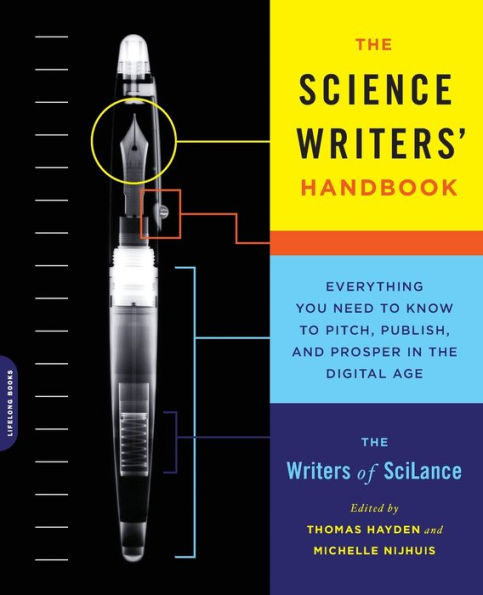
The Science Writers' Handbook: Everything You Need to Know to Pitch, Publish, and Prosper in the Digital Age
320
The Science Writers' Handbook: Everything You Need to Know to Pitch, Publish, and Prosper in the Digital Age
320Paperback
-
PICK UP IN STORECheck Availability at Nearby Stores
Available within 2 business hours
Related collections and offers
Overview

Product Details
| ISBN-13: | 9780738216560 |
|---|---|
| Publisher: | Hachette Books |
| Publication date: | 04/30/2013 |
| Pages: | 320 |
| Product dimensions: | 7.30(w) x 9.00(h) x 0.90(d) |
About the Author
thomas-hayden.com
Michelle Nijhuis is a freelance journalist and a longtime contributing editor of High Country News. Her work has appeared in numerous other publications including Smithsonian, National Geographic, the Atlantic, the New York Times, Orion, Audubon, and the Christian Science Monitor. A lapsed biologist, she specializes in long-form stories about conservation and global change, but she has covered subjects ranging from border security to wrestling. Her reporting on science and the environment has won multiple national journalism honors, and her writing has been included in the anthologies Best American Science Writing and Best American Science and Nature Writing. In 2011, as an Alicia Patterson Foundation fellow, she researched and wrote about the science and ethics of rescuing critically endangered species. She lives off the grid in rural western Colorado. michellenijhuis.com
Table of Contents
Foreword Kendall Powell ix
Part I The Skilled Science Writer
1 What Makes a Science Writer? Alison Fromme 3
2 Finding Ideas Emily Sohn 9
3 Making the Pitch Thomas Hoyden 23
Box: Classic Mistakes We Can All Avoid Monya Baker 32
Box: Pitching Endurance Douglas Fox 33
Box: A Tale of Two Query Letters Thomas Hayden 36
4 Getting the Story, and Getting It Right Andreas von Bubnoff 40
Box: Making a Reporting Plan 48
Box: A Science Writer's Emergency Question List 49
Box: On and Off the Record 50
Box: "So When Can I Read Your Draft?" 51
5 By the Numbers: Essential Statistics for Science Writers Stephen Ornes 53
6 Excavating the Evidence: Reporting for Narrative Douglas Fox 59
Box: Who Pays for Travel? 71
7 Sculpting the Story Michelle Nijhuis 75
Box: Story Anatomy 84
8 Working with Editors-and Their Edits Monya Baker Jessica Marshall 87
9 Going Long: How to Sell a Book Emma Marris 99
Box: Sample Query Letter 112
Box: The Six Steps to Authorship 114
10 Multilancing Robert Frederick 116
11 Just Write the Friggin' Thing Already! Anne Sasso 123
Box: Thirty Books in Thirty Days Emily Sohn 130
Part II The Sane Science Writer
12 The Loneliness of the Science Writer Stephen Ornes 137
13 Good Luck Placing This Elsewhere: How to Cope with Rejection Hillary Rosner 142
14 Beyond Compare Michelle Nijhuis 149
Box: Measuring Success in a World Without Performance Reviews Alison Fromme 154
15 An Experimental Guide to Achieving Balance Virginia Gewin 157
Box: How the &%@ Do I Take a Real Vacation? 163
Box: Balance, Schmalance Liza Gross 165
16 Creating Creative Spaces Hannah Hoag 167
17 Avoiding Domestic Disasters Bryn Nelson 175
18 Children and Deadlines: A Messy Rodeo Amanda Mascarelli 183
Part III The Solvent Science Writer
19 Minding the Business Anne Sasso Emily Gertz 195
20 Networking for the Nervous Cameron Walker 215
Box: The Introvert's Survival Guide for Conference Cocktail Parties 221
21 Paid to Grow Robin Mejia 223
22 Contract Literacy Mark Schrope 230
Box: Time and Money: Can I Afford This Project? Stephen Ornes 244
23 The Ethical Science Writer Brian Vastag 246
Box: The Journalism-Promotion Divide Helen Fields 256
24 Social Networks and the Reputation Economy Emily Gertz 259
Box: Blogging: My Digital Calling Card Sarah Webb 265
25 The Diversity of Science Writing Sarah Webb 267
26 Sustainable Science Writing Jill U Adams 273
Afterword: Finding, or Founding, Your Own Tribe Kendall Powell 279
Box: I Started My Own Group and So Can You Helen Fields 281
Acknowledgments 283
Contributors 285
Selected Resources 289
Index 301
